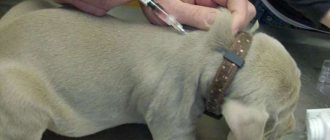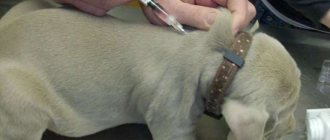The article was finalized and certified
Dubovitsky Yuri Igorevich
Veterinarian
Ask a Question
There are dogs for whom the need to swallow a tasteless pill is a simple matter; they seem to be omnivores. But still, in most cases, introducing tablets is a real stress for both the animal itself and its owner. It’s not so bad when drugs in solid form need to be given occasionally, but what to do if the dog needs to take tablets constantly?
How to properly give a pill to a dog
Feeding a pill to a small breed dog can be much more difficult than to large four-legged dogs. Some features of the drugs, the character of the animal - these factors influence the outcome of the event, but it is equally important who will carry out the procedure - the specialists of the veterinary clinic or the owner. If you have to treat your dog with tablets yourself, you should choose the most suitable options for yourself that will allow you to give the right medicine to your dog.
There are several ways to feed the tablet to your pet:
An introducer (tablet dispenser) or piller is similar in appearance to a syringe, but has a soft rubber tip - a special device for oral administration of medications to pets. Such a device has a lot of varieties - shape, size, manufacturer and can be used many times.
If the dog immediately notices the catch and spits out the tablet, or if the powder is to be given, the medicine is crushed. The method is especially effective if the dog is hungry. The drug should be crushed into fine powder or crumbs using a spoon and mixed with a small amount of viscous food (cottage cheese, porridge, meat stew or minced meat).
Not all drugs can be crushed, so sometimes you have to feed a tablet to a dog in this way: a suspension is prepared from the tableted drug - dissolved in a small amount of water (5 ml) - and administered using an introducer or spoon.
Without the use of improvised means, the easiest way to feed the tablet to the dog is using a treat. To do this, they use their favorite “yummy”: the medicine is hidden inside, either whole or pre-crushed. It is much easier to give your dog a suspension than a tablet or capsule. But tablets are a more common dosage form option in the veterinary industry.
The step-by-step process is presented below:
- Before starting to administer the tablet, the owner should make sure that the animal is in a calm state.
- You need to prepare the medicine in advance - the rustling of a blister of tablets and the owner with a jar of suspension will most likely arouse suspicion in the dog.
- Carefully study the instructions and recommendations of the veterinarian.
- The dog's head is held on top with the left hand. If the dog has a long nose, to feed the tablet, clamp the upper jaw between the thumb and forefinger of the right hand. When a dog has a short nose, the pet's head is held like a cat's.
- The muzzle is slightly tilted back and the upper jaw is pulled up.
- To feed a tablet or capsule, the drug is placed as far as possible on the tongue, then the mouth is immediately closed.
- You can force your pet to swallow the medicine in the following ways: stroke it from below with massaging movements. the dog's neck to trigger his swallowing reflex, or blow on his nose. After oral administration of the tablet, the animal should be offered water - it should be in the public domain.
Method number 4
If you need to give liquid medicine and the dog is calm and obedient, then you can slightly raise its head and pour the suspension from a spoon or syringe into the cheek space. The head is kept slightly tilted back for some time so that the medicine does not leak out.
If you need to give a suspension to a disobedient and energetic pet, you cannot do without an assistant. One person carefully fixes the pet's face and opens the jaws. Then, pulling back the cheek, inserts the index and middle finger into the mouth. As a result, a funnel-shaped hole is formed, into which a second person pours a sip (no more) of the medicine from a syringe, lifting the animal’s head up. The procedure is repeated until the entire suspension is gone. Between swallows, the dog's mouth is closed and the neck is stroked from top to bottom to facilitate swallowing.
There is another, easier way to administer liquid medicine, which does not require opening the animal’s mouth. The suspension is drawn into the syringe, after removing the needle from it. The volume of the syringe depends on the amount of medicine. Gently part the pet's lips from the side and slowly introduce liquid into the interdental space. If you press sharply on the syringe plunger, the mixture may fall not into the pharynx, but into the larynx. You also need to make sure that the nose of the syringe does not rest against the palate, gum or tongue. After administering the medicine, you need to hold the dog in the same position for a while so that it swallows the medicine.
Our pets are very different, and often we have to try many methods before finding a compromise. Nowadays, you can easily choose a dosage form that is convenient for you and your dog. This is especially true for anthelmintic drugs, which have to be given regularly. These drugs include the following:
- Dironet tablets
. This is a complex anthelmintic drug, the active ingredients of which are pyrantel pamoate, praziquantel and ivermectin. The advantages of Dironet tablets include a convenient dosage (suitable for animals with different body weights) and the presence of an aromatic flavoring additive; - suspension "Dironet"
. A drug with a wide spectrum of anthelmintic action. Active ingredients: pyrantel pamoate, praziquantel and ivermectin. The drug also contains a flavorful additive (salmon flavor for cats, fresh meat flavor for dogs); - suspension "Febtal-combo"
. This drug can be used for the treatment and prevention of nematodes and cestodes. Active ingredients: praziquantel and albendazole. The kit includes a dosing syringe.
When giving your pet medicine, you must show affection and patience, avoiding threatening intonations, irritability and nervousness, so as not to frighten or anger him. After taking the medication, be sure to pet and praise the dog.
How to feed a dog a deworming tablet
Prevention of helminthiasis in domestic dogs is recommended once every 30-40 days. Tablets are usually given both for medicinal and preventive purposes.
It can be difficult to give medicine to a dog correctly, since such drugs taste bitter. To give it to your pet, it is better to dilute it with a sweet liquid. This will help hide the unpleasant taste of bitterness as much as possible. It is better to purchase specialized anthelmintic drugs for dogs (for example, meat-flavored).
There are specifics for treating quadrupeds against helminths. Without knowing the specifics of treatment, you can make irreparable mistakes:
- To properly give the tablet to a pregnant dog, it is preferable to treat it for parasites in the second half of the term. To avoid trouble, it is better to do this procedure under the supervision of a veterinarian.
- The first deworming of puppies is carried out at 3-4 weeks of life. It is easier and more effective to treat small pets with a deworming suspension.
- When an anthelmintic drug is to be given to a lactating bitch, the tablet should be given no earlier than 2-3 weeks after the birth of the offspring.
- It is believed that before vaccination, treatment for helminths is inevitable - giving a tablet to a dog during this period means protecting the animal as much as possible from pathologies. Therefore, vaccinating a pet infected with worms is fraught with serious consequences.
- Most deworming medications are available separately for small and large breed dogs, as well as for puppies. This allows you to select and feed a tablet that is suitable for the weight and age of your pet. All such medications are given to the dog in the morning on an empty stomach.
How to properly give your dog allergy medicine
For long-term control of itching and allergy symptoms, there are many medications available in the form of tablets, capsules, and sprays. It is preferable to act according to the recommendation of the veterinarian; it is he who decides whether to give the dog a tablet or suspension, or whether urgent help is required (injections, droppers). Based on the individual characteristics of the animal, treatment is selected, nutrition is adjusted, and seasonal prevention of skin parasites is carried out.
How to properly give antihistamine medication to a dog:
- Allergy medications are given to pets at any time of the day, regardless of food intake. It is recommended to give antihistamines with food.
- When using allergy pills, take into account the pet’s age and health status. Such drugs are not always recommended in tablet form for lactating and pregnant females.
Antihistamines are available in both capsules and tablets. Dogs tolerate allergy medications intended for humans well (for example, Suprastin, Tavegil). But it should be remembered that the necessary treatment is always selected by a specialist.
Most likely, your veterinarian will recommend using specially formulated antihistamines for dogs. They have fewer side effects, are safer and guarantee successful treatment of allergies if symptomatic therapy is followed.
Briefly about the main thing
- For treatment to have a positive result, the dog must take the medications correctly. Every owner should know how to administer therapeutic agents into the animal's body.
- Tablets can be added to food if permitted by the instructions.
- Forced administration of the drug is allowed if it is not possible to give the medicine otherwise; the main thing is to act confidently, but carefully.
- For manipulation, you can use an Introducer; thanks to this device, you can easily place the product on the tip of your four-legged friend’s tongue.
- If you need to give the drug in liquid form, it is recommended to use a dispenser.
Have we answered your question fully enough? If not, post your question in the comments below and our veterinarian will answer it.
Did you like the article? Share it with your friends on social media. networks. This will help them get useful information and support our project.
How to give a dog a tablet or capsule if it won't eat
Most often, if it is impossible to feed a tablet or capsule to a dog with a treat, as well as in the absence of a piller, the drug is administered intramuscularly (intravenously) or rectal suppositories are used. If the specialist prescribed tablets and the dog refuses to eat, you will not be able to give the required dose of medication with food. In this case, it is recommended to use special veterinary flavored tablets. In the absence of an introducer, it is recommended to dissolve the tablet and administer it orally using a regular syringe (without a needle) into the pet’s oral cavity.
How to give tablets to a small breed dog
A small four-legged friend will not be able to handle a solid drug or capsule - a piller will help to give the tablet to a small breed correctly. But there are times when a special device is not at hand. The most convenient way to feed a tablet to a small dog is to offer it “decoy”, that is, by disguising the medicine in a favorite food, or give the tablet medication in crushed form, mixed with food or water - then the dog will not choke when swallowing.
It is safer to carry out all manipulations with the baby by wrapping him in a blanket or a small blanket - especially since the size of small dogs allows this. Then the pet will not behave violently - since its movements are limited, and will not scratch its owner with its claws - even if the tablet is given using an introducer.
Recommendations for the owner
The process of giving a dog a pill should not turn into torture for both the owner and the dog. To prevent this from happening, it is recommended to follow simple rules:
- Gently call the animal to you and stroke its head. Gain her attention and trust in you. Don't grab your dog suddenly. This will scare her and she will expect something scary.
- If the dog is too excited, for example, after walking outside or playing in the room, then it is better to wait until he calms down and only then give the tablets.
- If you are afraid that you won’t be able to cope on your own, for example, you won’t be able to open your mouth and put a pill on your tongue at the same time, then call an adult family member for help. It is not recommended to call strangers, as the animal can become aggressive.
- Prepare the medicine in advance: remove it from the package or jar, remove it from the blister or divide it into parts, if necessary, mix it with food or hide it in a treat.
- Tablets, the dosage of which must be observed taking into account the weight of the animal, should be given only after preliminary weighing of the dog. It is strictly forbidden to determine body weight “by eye”. This is fraught with overdose.
- It is not recommended to cover the dog with a blanket or other blanket or squeeze it between the legs. This will greatly frighten the pet, which will lead it to a state of stress, aggression or severe fear. In this case, you will not be able to get close to him for a long time.
Under no circumstances should the owner shout, knock or jerk the animal. Remain as calm and patient as possible. If you didn’t manage to give the whole tablet the first time, try the second method, crush it or mix it with water.
Important! Puppies remember the first time they take the tablets for a long time. If the procedure was unpleasant or stressful for him, then this will be remembered forever.
If there is no time limit for taking the medication, many veterinarians recommend giving the tablets to dogs in the morning, before their first meal. This is the most convenient time when the pet is hungry after the night and eats everything indiscriminately.
How to give your dog medicine from a syringe
When it comes to giving a pill to your dog, a syringe is a great alternative to a pill. The device is most often within walking distance. In addition, a regular medical syringe is more affordable than newfangled introducers.
How to properly give medicine to a dog using a syringe:
- The dosage is determined in advance according to the instructions and recommendations of knowledgeable experts; in order to give the tablet to the dog, the drug is crushed into powder.
- Add water to the prepared mixture according to the volume of the syringe (5-10 ml). It depends on the breed and age of the dog - a puppy should choose a small syringe, a large-breed dog will need a larger volume.
- The medicine is considered ready for use if the tablet is completely dissolved in the liquid.
- The syringe is released from the needle.
- The liquid is drawn into a syringe and injected between the pet’s cheek and teeth.
They squeeze the mouth and make sure that the dog has swallowed the medicine. After this, you should let the animal drink.
How to give your dog powdered medicine
Most medications presented on the veterinary market are available in the form of tablets and suspensions, sometimes coated medications are available - capsules. But not all medications are allowed to be dissolved in liquid. Then most often it is convenient to give the tablet to the dog in powder form. To do this, you will have to turn the tablet form into powder or extract the contents of the capsule.
How to treat four-legged animals with powdered drugs:
It is convenient to combine ready-made or pre-prepared powder with your pet’s favorite food. To properly give medicine to a dog, the medicine is mixed with curd mass, pate, grated cheese, minced meat or thick porridge - it all depends on the dog’s gastronomic preferences.
The “patient” will happily enjoy the decoy with medicinal powder, without even noticing the catch. After the procedure, the dog should be given something to drink.
What medications should not be given to dogs?
It is not recommended to treat dogs with drugs purchased at a regular pharmacy, especially without the recommendation of a specialist. Only exceptional medications are acceptable for treating pets - only a veterinarian knows how to properly give medicine to a dog.
Even if you don’t have a veterinary kit at hand at the right time, you should not resort to treating dogs using the following means:
- ibuprofen and paracetamol, all other phenol-containing drugs;
- aspirin and its analogues;
- no-shpa;
- non-steroidal anti-inflammatory drugs;
- corticosteroids (Dexafort, Prednisolone, Dexamethasone);
- various sedatives, even on a natural basis.
Only a veterinarian can prescribe appropriate treatment and select the dosage form and dosage - then the treatment will be effective and safe.
An important point is that the whole procedure should take place in a friendly environment, without pressure - the four-legged friend will definitely appreciate the care of the owner and will behave accommodatingly. Every caring owner can give medicine to their dog correctly; the main thing is to do it wisely and responsibly to their pet.
Without improvised means
If you don’t have a tablet dispenser at hand, you can follow a similar algorithm without it.
- The dog should be standing, sitting or lying on its stomach. If she resists, ask someone at home to hold her.
- Take the tablet in your right hand (or left if you are left-handed).
- To get your pet to open its mouth, use the thumb and forefinger of your other hand to lightly press on the gap between the teeth.
- Place the medicine on the root of your tongue and immediately close your mouth
- Point the muzzle up and hold it with your hand so that the dog cannot open its mouth.
- Release your dog when he swallows. This will happen faster if you stroke the area of the throat between the head and neck.











